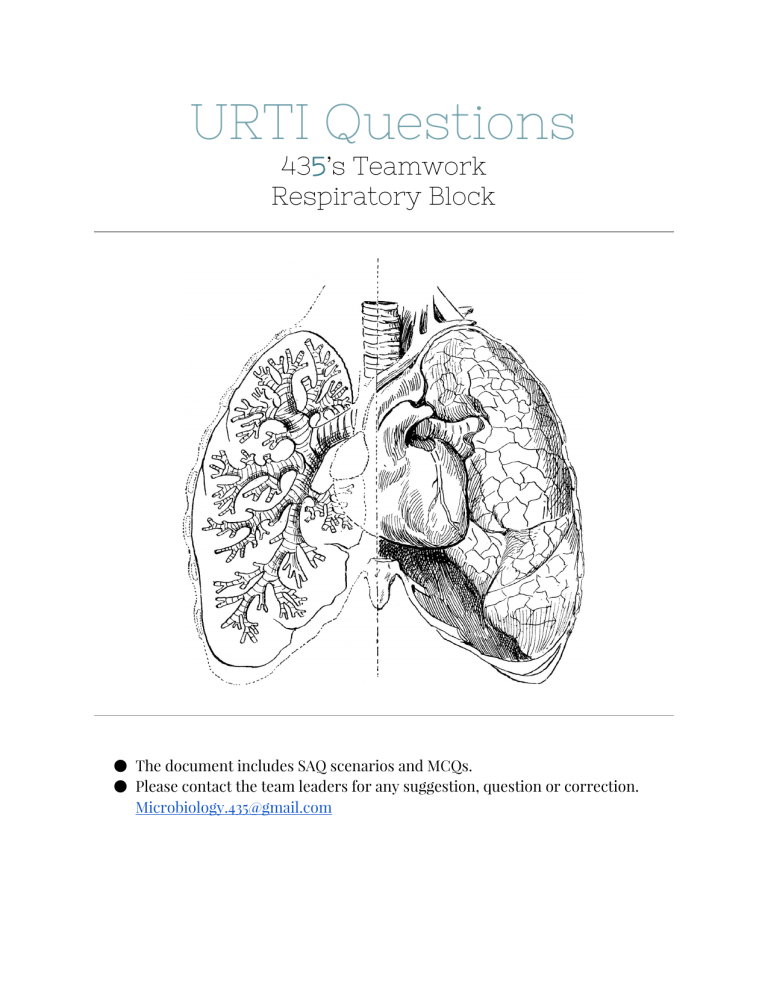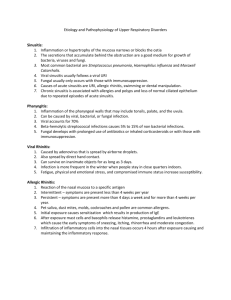
URTI Questions 43 5 ’s Teamwork Respiratory Block ● The document includes SAQ scenarios and MCQs. ● Please contact the team leaders for any suggestion, question or correction. Microbiology.435@gmail.com MCQs Q1: What is the most common causes of death in “unvaccinated” children 1­5 years? A | Neisseria gonorrhoeae. B | Corynebacterium diphtheriae. C | Group A streptococcus. D | Anaerobic bacteria. Q2: Which of the following diseases is “Mimic allergic rhinitis” ? A | Acute sinusitis. B | Acute otitis media. C | Chronic sinusitis. D | Epiglottitis. Q3: The “Epiglottis” usually affect young children who are? A | Unimmunized. B | Unvaccinated. C | Normal. Q4: What is the “Danger space” infection that may extend to mediastinum? A | Lateral pharyngeal. B | Retropharyngeal. C | Prevertebral. D | Postvertebral. Q5: The duration of “Ceftriaxone” for treatment of “Acute sinusitis” is ? A | 1 ­ 2 weeks. B | 2 ­4 weeks. C | one month. D | four days. Q6: A young child with fluid in the middle ear and there is a formation of pus. after that he lost hearing. he most likely has? A | Lemierre's syndrome. B | Acute sinusitis C | diphtheria. D | Acute otitis media. Q7: How many weeks in “Incubation period”? A | 1 ­ 3 weeks. B | 1 ­ 2 weeks. C | 1 ­ 6 weeks. D | 3 ­ 6 weeks. Q8: Dysphagia, fever, drooling of the saliva and stridor are the signs of? A | Pharyngitis. B | Sinusitis. C | Acute otitis media. D | Epiglottitis. Q9: How many stages in “Pertussis”? A | One. B | Two. C | Three. D | Four. Q10: It is a “toxin mediated disease”? A | Corynebacterium diphtheriae. B | Sinusitis. C | Acute otitis media. D | Epiglottitis. Answer key: ( Q1:B ­ Q2: C ­ Q3: A ­ Q4: B ­ Q5: A ­ Q6:D ­ Q7: A ­ Q8: D ­ Q9: C ­ Q10: A) SAQs (1): Jason is not a happy little boy. For the past hours he has complained of pain when he swallows, has a headache, and has vomited twice. His mother decides to take the seven­year­old to his pediatrician. Upon examining Jason, the doctor fi nds that Jason’s pharynx, tonsils, and uvula are swollen and erythematous (red) and his tonsils are studded with white areas of exudate. He is febrile (temperature . degrees centigrade) with tender, bilateral, cervical lymphadenopathy (enlarged lymph nodes). the (CBC) performed on a sample of Jason’s blood reveals that he has a leukocytosis. Answer: Acute bacterial pharyngitis. Explanation: He is a 7 years old. The symptoms of pharyngitis are tender, enlarged lymph nodes, high temperature and erythematous. and because he can not swallow his pharynx and tonsils got either viral or bacterial infection. In our case he has a bacterial infection because of the increase of WBC’s (Leukocytosis) due to an inflammation that caused his pharynx to swollen and present a white area of exudate. (2): A 41 year old male physician presents with 6 weeks of nasal congestion, yellow­green sinus drainage, fatigue, and intermittent facial and head pain. His symptoms started as a post­nasal drip, and then progressed to nasal congestion with the aforementioned sinus drainage. Answer: Acute bacterial sinusitis. Explanation: Bacterial sinusitis is usually self­limited and resolves within 7 to 10 days. The main symptoms of sinusitis are facial and yellow­green sinus drainage. (3): A two­years­old child has Dysphonia (Changes in the voice) with a grayish exudate in the posterior pharynx and massive, tender cervical lymphadenitis is most likely caused by: Answer: Corynebacterium diphtheriae. Explanation: This an aerobic gram­positive rod cause of “Diphtheria”. A hallmark feature of the disease in the development of a grayish over the tonsils ,larynx and pharynx. it’s affected the unvaccinated children 1­5 years and cause death.





